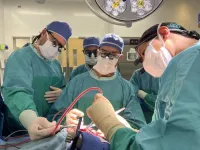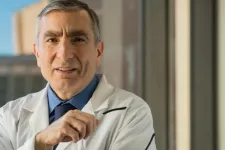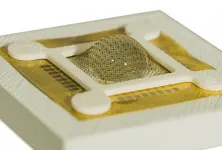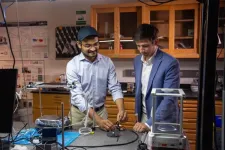(Press-News.org) Some private UK biobanks may be misleading expectant parents about the value of storing umbilical cord blood to treat life-threatening diseases that may arise in their child in the future, reveals an investigation by The BMJ, published today.
Over the past decade growing numbers of parents have chosen to store blood from the umbilical cord, which contains stem cells, in case their infant develops a condition that could be treated with stem cell therapy.
Parents must use a private biobank which charges around £550 to £3000 for freezing a baby’s umbilical cord blood. On top of this, parents must pay an annual storage fee of over £100 to keep samples frozen.
Private biobanks market their umbilical cord blood banking services to expectant parents as an investment in protecting their child’s future health alongside claims that stem cell based therapies have been used successfully to treat a wide range of potentially life-threatening diseases, from cerebral palsy to leukaemia.
But experts in regenerative medicine say many of these companies’ marketing claims are misleading.
For example, Cells4Life, which describes itself as the UK’s largest provider of cord blood banking services, claims that “umbilical cord blood is routinely used in treatments for over 80 different conditions and diseases,” including cancers, blood disorders, immune disorders, and autism. It adds that umbilical cord blood stem cells are “pure and plastic,” meaning that “they can become almost any tissue type in the body and may even be used to regrow entire organs.”
The investigation also found that Cells4Life markets its services on questionable evidence published in the Journal of Stem Cells Research, Development & Therapy. Although the journal claims to operate a peer review process, the research article referenced by Cells4Life was published in the journal just 17 days after receipt—a timescale far shorter than the 12-14 weeks typical for peer reviewed journals. The BMJ contacted two editors listed on the journal’s editorial board who said they did not in fact hold these roles.
SmartCells, another private cord blood bank service, claims on their website that the possibilities for using stem cells are endless as these cells “have the ability to repair, replace, and regenerate cells of almost any kind.” The website of another service, Future Health, lists more than 75 genetic, immune and blood disorders that can be treated.
Charles Murry, director of the Institute for Stem Cell and Regenerative Medicine at the University of Washington, Seattle, and Pietro Merli, a paediatrician at the Bambino Gesù Pediatric Hospital in Italy, said the list of applications is unrealistic.
Murry says the list is based on claims by people in the late 1990s that these cells have the plasticity to become almost any type of cell in the body—claims which have been “very rigorously disproven.”
He said that umbilical cord blood contains adult stem cells which limits the types of cells they can become—haematopoietic stem cells (HSCs) can become blood cells, and mesenchymal stem or stromal cells (MSCs) can build connective tissue such as bone, cartilage, tendons, ligaments, muscles, and bone marrow.
Cells4Life said, “Any cursory search of published literature on future applications of perinatal stem cells demonstrates the huge potential that cord blood holds for use in regenerative medicine in the future.”
It pointed to research which suggests that MSCs can be transformed into inducible pluripotent stem cells (iPSCs) which can mimic embryonic stem cells and are therefore capable of forming any tissue except germ cells (precursors of egg and sperm cells).
Murry highlighted that transforming stem cells into iPSCs requires highly trained stem cell scientists and that iPSCs can also be created from adult blood or skin cells meaning that cord blood banking is unnecessary.
Merli, who uses stem cell therapy to treat his patients, says many of the conditions he treats do not require autologous stem cells (harvested from the patient) and that allogeneic stem cells (from matched donors) can be used instead.
He said that leukaemia was one of the few conditions where doctors might use stem cells harvested from the patient, but that these could be taken from the patient’s bone marrow so there was no benefit to harvesting and storing stem cells from cord blood.
He added that in Italy it is illegal for stem cell therapy companies to make such claims in their advertising.
Neither SmartCells nor Future Health responded to The BMJ’s request for comment.
Both the Royal College of Obstetricians and Gynaecologists and the Royal College of Midwives do not recommend commercially harvesting umbilical cord blood, unless there's a specific medical reason to do so.
[Ends]
END
Some private biobanks overinflating the value of umbilical cord blood banking in marketing to expectant parents
Regenerative medicine experts warn companies are suggesting “unrealistic” applications for umbilical cord stem cell treatments
2024-07-25
ELSE PRESS RELEASES FROM THIS DATE:
New research in fatty liver disease aims to help with early intervention
2024-07-25
A new study brings researchers closer to better understanding the pathology of the fatty liver disease MASH, which stands for metabolic dysfunction-associated steatohepatitis.
MASH is a consequence of poor diet and obesity and results in severe damage to the liver. In MASH, the liver becomes filled with active and rapidly multiplying T cells, which are a type of immune cell.
In today’s study, published in Hepatology, researchers examine what these T cells look like and how they work in people with liver cirrhosis (a late stage of liver disease) and in an animal ...
Genetics reveal ancient trade routes and path to domestication of the Four Corners potato
2024-07-25
A new study shows that a native potato species was brought to southern Utah by Indigenous people in the distant past, adding to an ever-growing list of culturally significant plant species that pre-contact cultures domesticated in the Southwestern U.S.
The team of researchers, led by Red Butte Garden and the Natural History Museum of Utah (NHMU) at the University of Utah, used genetic analysis to reveal how and where tubers of the Four Corners potato (Solanum jamesii) had been collected, transported and traded throughout the Colorado Plateau. The findings support the assertion that the tuber is a “lost sister,” joining maize, beans and squash—commonly ...
SNIS 2024: New study shows critical improvements in treating rare eye cancer in children
2024-07-25
FOR IMMEDIATE RELEASE: July 24, 2024, 3:20 P.M. MDT
CONTACT: Camille Jewell
cjewell@vancomm.com or 202-248-5460
COLORADO SPRINGS, Colo. — The evolution of retinoblastoma treatment over the past 15 years has resulted in a higher likelihood of vision preservation without compromising survival, according to research released today at the Society of NeuroInterventional Surgery’s (SNIS) 21st Annual Meeting.
Retinoblastoma, a rare eye cancer that affects young children, carries a risk of impaired vision and removal ...
Wearable devices can increase health anxiety. Could they adversely affect health?
2024-07-24
Using a wearable device, such as a smart watch, to track health data and symptoms, is supposed to help people monitor their health and address symptoms as quickly as possible to spur positive health outcomes. But for people with atrial fibrillation, also known as Afib, using a wearable device to monitor the heart rate and to alert wearers of an irregular heartbeat might not be as helpful as wearers think.
A new study in the Journal of the American Heart Association, led by Lindsay Rosman, PhD, assistant professor of medicine in the ...
Addressing wounds of war
2024-07-24
Dr. Olga Denysiuk, MD, PhD, is a highly skilled eye surgeon in Ukraine who now finds herself at the frontlines of ophthalmic trauma care caused by war.
“Every day, I am fighting my war in the operating room,” says Denysiuk. “Cases of eye trauma are mounting and it’s critical that we have surgeons trained to delicately manage eyelid and orbital injuries.”
Denysiuk is one of two ocular specialists selected for a unique humanitarian fellowship at the University of Calgary’s ...
Rice researchers develop innovative battery recycling method
2024-07-24
A research team at Rice University led by James Tour, the T.T. and W.F. Chao Professor of Chemistry and professor of materials science and nanoengineering, is tackling the environmental issue of efficiently recycling lithium ion batteries amid their increasing use.
The team has pioneered a new method to extract purified active materials from battery waste as detailed in the journal Nature Communications on July 24. Their findings have the potential to facilitate the effective separation and recycling of valuable battery materials ...
It’s got praying mantis eyes
2024-07-24
Self-driving cars occasionally crash because their visual systems can’t always process static or slow-moving objects in 3D space. In that regard, they’re like the monocular vision of many insects, whose compound eyes provide great motion-tracking and a wide field of view but poor depth perception.
Except for the praying mantis.
A praying mantis’ field of view also overlaps between its left and right eyes, creating binocular vision with depth perception in 3D space.
Combining this insight with some nifty optoelectrical engineering and innovative “edge” ...
Stroke recovery: It’s in the genes
2024-07-24
New research led by UCLA Health has found that specific genes may be related to the trajectory of recovery for stroke survivors, providing doctors insights useful for developing targeted therapies.
Published in the journal Stroke this month, the findings were part of an exploratory study that sought to find if candidate genes could predict a higher likelihood of stroke outcomes related to depression, post-traumatic stress disorder and cognitive decline.
Dr. Steven C. Cramer, MD, the study’s lead author and a professor of neurology at UCLA, said while there are some ...
Foam fluidics showcase Rice lab’s creative approach to circuit design
2024-07-24
HOUSTON – (July 24, 2024) – When picturing next-generation wearables and robotics, the foam filling in your couch cushions is likely not the first thing that comes to mind.
However, Rice University engineers have shown that something as simple as the flow of air through the airy, meshlike structure of open-cell foam can be used to perform digital computation, analog sensing and combined digital-analog control in soft textile-based wearable systems.
“In this work, we integrated material intelligence — the ability of materials to sense and respond to their environment ...
Montana State scientists publish evidence for new groups of methane-producing organisms
2024-07-24
A team of scientists from Montana State University has provided the first experimental evidence that two new groups of microbes thriving in thermal features in Yellowstone National Park produce methane – a discovery that could one day contribute to the development of methods to mitigate climate change and provide insight into potential life elsewhere in our solar system.
The journal Nature this week published the findings from the laboratory of Roland Hatzenpichler, associate professor in MSU’s Department of Chemistry and Biochemistry in the College ...
LAST 30 PRESS RELEASES:
Doing good pays off: Environmentally and socially responsible companies drive value and market efficiency
City of Hope and Cellares to automate manufacturing of solid tumor CAR T cell therapy
Short-circuiting pancreatic cancer
Groundbreaking mapping: how many ghost particles all the Milky Way’s stars send towards Earth
JBNU researchers propose hierarchical porous copper nanosheet-based triboelectric nanogenerators
A high-protein diet can defeat cholera infection
A more accurate way of calculating the value of a healthy year of life
What causes some people’s gut microbes to produce high alcohol levels?
Global study reveals widespread burning of plastic for heating and cooking
MIT study shows pills that communicate from the stomach could improve medication adherence
Searching for the centromere: diversity in pathways key for cell division
Behind nature’s blueprints
Researchers search for why some people’s gut microbes produce high alcohol levels
Researchers find promising new way to boost the immune response to cancer
Coffee as a staining agent substitute in electron microscopy
Revealing the diversity of olfactory receptors in hagfish and its implications for early vertebrate evolution
Development of an ultrasonic sensor capable of cuffless, non-invasive blood pressure measurement
Longer treatment with medications for opioid use disorder is associated with greater probability of survival
Strategy over morality can help conservation campaigns reduce ivory demand, research shows
Rising temperatures reshape microbial carbon cycling during animal carcass decomposition in water
Achieving ultra-low-power explosive jumps via locust bio-hybrid muscle actuators
Plant-derived phenolic acids revive the power of tetracycline against drug-resistant bacteria
Cooperation: A costly affair in bacterial social behaviour?
Viruses in wastewater: Silent drivers of pollution removal and antibiotic resistance
Sub-iethal water disinfection may accelerate the spread of antibiotic resistance
Three in four new Australian moms struggle with body image
Post-stroke injection protects the brain in preclinical study
Cardiovascular risk score predicts multiple eye diseases
Health: estimated one in ten British adults used or interested in GLP-1 medications for weight loss
Exercise to treat depression yields similar results to therapy
[Press-News.org] Some private biobanks overinflating the value of umbilical cord blood banking in marketing to expectant parentsRegenerative medicine experts warn companies are suggesting “unrealistic” applications for umbilical cord stem cell treatments




